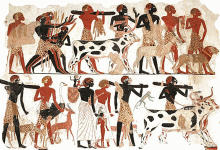Let’s start with the beginning; domestication. People very early on figured out that training animals to bear one’s workload, provide food and safety, and even to be one’s faithful companion, was a useful application of their intelligence. As a result, livestock have followed nearly every human population as it moved across the globe. Horses, for instance, died out on the North American continent about 10,000 years ago. However, herds of wild horses spread across the Bearing Strait onto the Asian continent and so were domesticated by humanity as it slowly developed civilization. Fast forward to the sixteenth century, when Spanish explorers brought horses back to the Americas where most of their evolutionary progress had actually taken place.
Dogs are perhaps the most versatile and longest domesticated species in human history, and as such, they have been bred and evolved into nearly as many different breeds and types as there are different human communities. Dogs have been used throughout history for everything from hunting and war, to companionship or even as a food source. The Shiba Inu is a mid-sized, efficient, and highly-intelligent dog from Japan that was bred for service and battle, as was the English Bulldog and Mastiff; large powerful dogs to knock armored men on their backs. On the other hand the Dauchsund was bred in Germany for the purposes of hunting rodents and vermin that were plaguing their cities in the middle ages, small and long to navigate subterranean tunnels.
Of course, there are the unintended traces as well. Mice, which can be found nearly anywhere human beings are, have followed the movements of human populations since there were any. Mice have been particularly talented at adapting to human civilization and using it as a kind of “natural” habitat. Once recent piece of evidence is from the Vikings of the 9th and 10th centuries. Mice followed Viking explorers to Iceland, Greenland, and Newfoundland (in present-day Canada). However, perhaps indicating how important humans are to some of these species that seem to mirror our movements, just as the Vikings died out in Greenland and Newfoundland so too did their Nordic mice.
